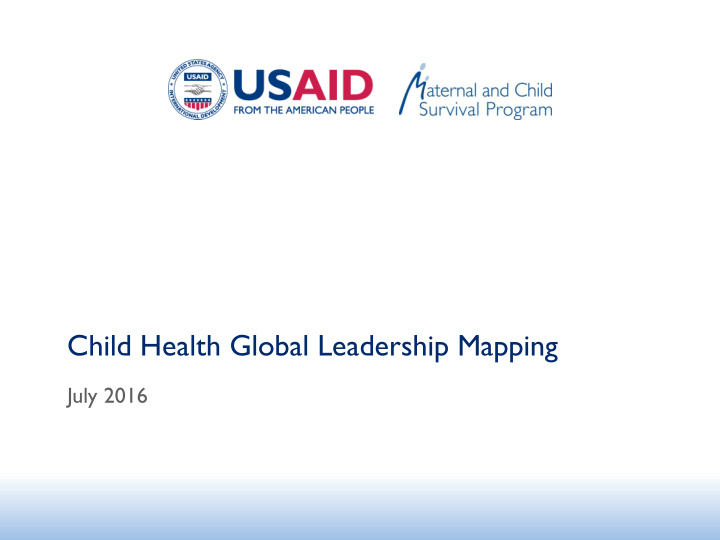



Child Health Global Leadership Mapping July 2016
Study Aims: • Better understand the evolution of child health as a global health issue since the year 2000, and its network of stakeholders and leaders. • Explore how leadership might be strengthened and child health repositioned by the community to better attain outcomes in the current time period. Data Collection and Analysis: • Reviewed published literature and other reports on global child health policy, child health programs, funding, and global health partnerships • Conducted over 30 in-depth interviews of child health experts and stakeholders from donors, development partners, and non-governmental organizations • Data were analyzed by evaluation question and aligned with a framework on the effectiveness of global health networks first proposed by Jeremy Shiffman.
Strategic Environment The level of uncertainty for development support is high in the near term. It will be important to remain aware and predict change. Implications of SDGs are emerging, but priorities, political commitment, and funding will be more broadly distributed. If any of these are ‘zero - sum’, child health (other than immunization) can expect to be working with less. No one knows yet how well the GFF will work. The high level core architecture for RMNCAH is emerging. Tracking the place and priority of child health within this architecture will be important.
Issue Characteristics • Children are valued • Stunning success of mortality reduction under MDGs • Well proven effective solutions • Immunization/malaria had more impact than pneumonia/diarrhea • Newborn death relatively more important • Perception that job is done • But unfinished agenda/preventable deaths and equity issues remain
Network and Actor Features • No clear global champion for child health for 20 years • Weak leadership/other priorities for organizations with CH mandate • MDGs >2003 + CS technical network + Countdown galvanized momentum • Weaknesses of IMCI, CH reverts to technical intervention-specific groups • >2010 Surfeit of initiatives, branding • CH is highly fragmented and siloed • Country level locus and leadership is critical
Policy Environment • 2003 MDGs + 2010 EWEC high level commitment to MNCH • Funding (DAH) has increased, not as sharply as immunization/polio • Largest DAH sources UK, USG, Gates • Countdown reporting, accountability key to raising commitment • Newborn, maternal health more visible /PMNCH low interest in CH • Dilution of focus with shift to SDGs • Tipping point, high uncertainty now
R ECOMMENDATIONS Reco 1: Reframing Child Health Reco 2: Re-establishing Leadership Recos 3 & 4: Reversing Fragmentation and Coordinating Effectively Reco 5: Data and Accountability Reco 6: Country Level Focus
R EFRAMING C HILD H EALTH Recommendation 1: With the shift to the SDGs, child health should be deliberately reframed so that it emphasizes the value of children, a more holistic approach including “newborns and infants and children” as one, and a clear aim for equity.
R E - ESTABLISHING L EADERSHIP Recommendation 2: a) The principal global partners in child health need to come to agreement on and then designate and support a lead organization to consistently provide overall messaging for child health. b) They also need to seek and nurture over time one or several credible champions who will speak powerfully for child health on the global stage.
R EVERSING F RAGMENTATION AND C OORDINATING E FFECTIVELY Recommendation 3: Key stakeholders need to create and implement a shared strategic approach for: a) Raising the visibility of child health as a whole rather than in subcomponents; b) Ensuring a strong child health voice in Strategy 2.0, SDG3 monitoring, and the GFF; and c) Bridging child health components of existing strategies across institutions in such a way that country action is more likely. d) In addition, investments should support collaboration and explicitly dis-incentivize fragmentation within child health.
R EVERSING F RAGMENTATION AND C OORDINATING E FFECTIVELY Recommendation 4: Focus on a few key coordinating mechanisms for child health and support their performance appropriate to objectives, role and participants. Close those that do not provide enough value at both global and country levels.
D ATA AND A CCOUNTABILITY Recommendation 5: Ensure that child health data and information are well represented, packaged, and reported within the context of the emerging evaluation groups.
C OUNTRY L EVEL F OCUS Recommendation 6: Reframe child health with the country at the center and purposely engage differently with countries with weaker systems and leadership to sustainably improve child health. Invest in tracking and learning from the process.
Recommend
More recommend